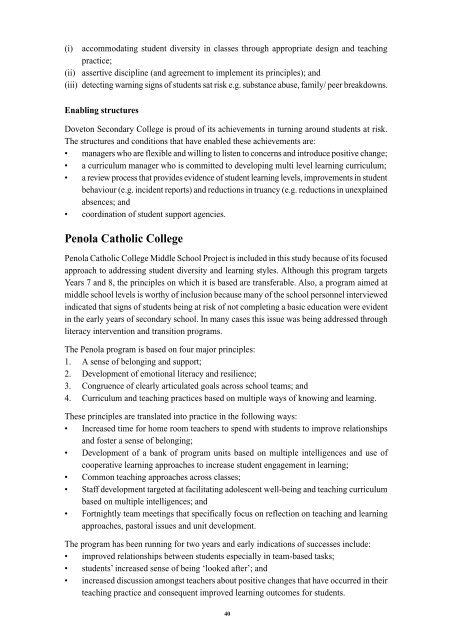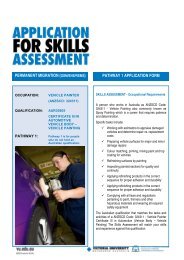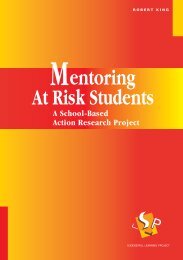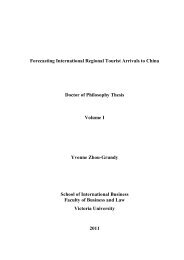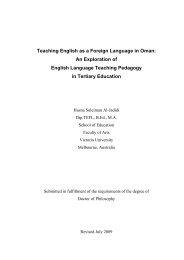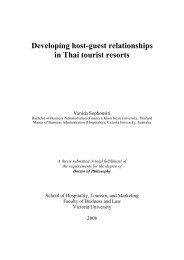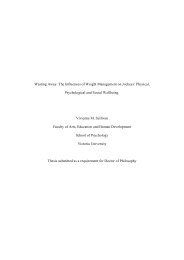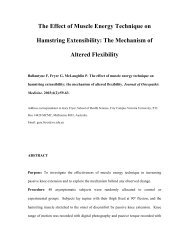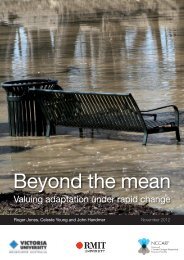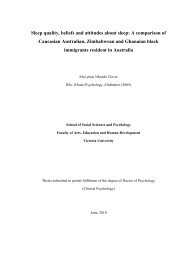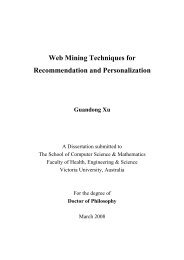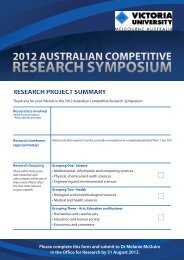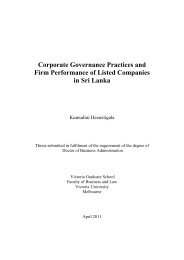Providing Education and Training for At Risk ... - Victoria University
Providing Education and Training for At Risk ... - Victoria University
Providing Education and Training for At Risk ... - Victoria University
- No tags were found...
You also want an ePaper? Increase the reach of your titles
YUMPU automatically turns print PDFs into web optimized ePapers that Google loves.
(i) accommodating student diversity in classes through appropriate design <strong>and</strong> teachingpractice;(ii) assertive discipline (<strong>and</strong> agreement to implement its principles); <strong>and</strong>(iii) detecting warning signs of students sat risk e.g. substance abuse, family/ peer breakdowns.Enabling structuresDoveton Secondary College is proud of its achievements in turning around students at risk.The structures <strong>and</strong> conditions that have enabled these achievements are:• managers who are flexible <strong>and</strong> willing to listen to concerns <strong>and</strong> introduce positive change;• a curriculum manager who is committed to developing multi level learning curriculum;• a review process that provides evidence of student learning levels, improvements in studentbehaviour (e.g. incident reports) <strong>and</strong> reductions in truancy (e.g. reductions in unexplainedabsences; <strong>and</strong>• coordination of student support agencies.Penola Catholic CollegePenola Catholic College Middle School Project is included in this study because of its focusedapproach to addressing student diversity <strong>and</strong> learning styles. Although this program targetsYears 7 <strong>and</strong> 8, the principles on which it is based are transferable. Also, a program aimed atmiddle school levels is worthy of inclusion because many of the school personnel interviewedindicated that signs of students being at risk of not completing a basic education were evidentin the early years of secondary school. In many cases this issue was being addressed throughliteracy intervention <strong>and</strong> transition programs.The Penola program is based on four major principles:1. A sense of belonging <strong>and</strong> support;2. Development of emotional literacy <strong>and</strong> resilience;3. Congruence of clearly articulated goals across school teams; <strong>and</strong>4. Curriculum <strong>and</strong> teaching practices based on multiple ways of knowing <strong>and</strong> learning.These principles are translated into practice in the following ways:• Increased time <strong>for</strong> home room teachers to spend with students to improve relationships<strong>and</strong> foster a sense of belonging;• Development of a bank of program units based on multiple intelligences <strong>and</strong> use ofcooperative learning approaches to increase student engagement in learning;• Common teaching approaches across classes;• Staff development targeted at facilitating adolescent well-being <strong>and</strong> teaching curriculumbased on multiple intelligences; <strong>and</strong>• Fortnightly team meetings that specifically focus on reflection on teaching <strong>and</strong> learningapproaches, pastoral issues <strong>and</strong> unit development.The program has been running <strong>for</strong> two years <strong>and</strong> early indications of successes include:• improved relationships between students especially in team-based tasks;• students’ increased sense of being ‘looked after’; <strong>and</strong>• increased discussion amongst teachers about positive changes that have occurred in theirteaching practice <strong>and</strong> consequent improved learning outcomes <strong>for</strong> students.40


